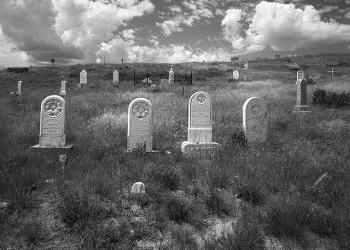- Home
- Encyclopedia
- Carbon Cemetery
Carbon Cemetery

The Carbon Cemetery lies nine miles southwest of the town of Medicine Bow in Carbon County, Wyo. on private land. The cemetery is small, only about five acres. The landscape surrounding the cemetery is relatively flat, covered in natural grasses, with few trees. The old town of Carbon lies over a rise just to the south, and is not visible from the cemetery. Old foundations, roads, mine ruins, and the cindered roadbed of the original line of the Union Pacific Railroad may be found in the town today.
The cemetery was most active from 1868 to 1902, while people still lived in Carbon. The cemetery has changed little since the 1940s, when it began being used less frequently. Family and friends continued to maintain individual plots, however. The most recent burial was in 1995, and there are some prospective future burials.
According to the Carbon Cemetery Association, the site has 239 marked graves; another 98 documented burials are no longer identified by markers. Additional unmarked graves may be present. Many headstones are marked with family names and indicate multiple burials at one location. The names indicate that many Carbon residents were largely from the British Isles, Finland, Sweden, Denmark, and Germany.
Most of the unnamed graves are marked with stone cairns or small stone rectangles. These were probably marked with wooden crosses indicating the name of the deceased, and have deteriorated over the years from harsh weather. Of the graves that have headstones, most are granite and marble.
Most notable, and most culturally connected, are the Finnish grave-markers. All consist of a tall vertical metal bar with a flat vertical metal plate bolted to the top. The metal plates were painted with information about the deceased, but today are blank, from weathering. Similar markers are found in historic cemeteries in the “rural area surrounding Lake Lappajarvi, Finland, in the west-central area of the country,” according to Ron Sladek, author of the document nominating the site for the National Register of Historic Places. The burial tradition using metal grave-markers was brought to southern Wyoming by Finnish miners and their families.
Local supporters formed the Carbon Cemetery Association in 2002 and revived an organized effort at maintaining the cemetery, with volunteers “refurbishing the place and rebuilding the stories of the people who are buried there,” says Nancy Anderson, of the association and the Hanna Museum.
In October 2010, Anadarko Petroleum Corporation deeded forty acres to the Carbon Cemetery Association. Included in these acres are part of the Caron townsite and about one-third of the cemetery's fenced area.
A post and wire fence marks the perimeter of the cemetery. The wooden posts are reinforced by pipes cut from the steam system of Carbon's # 2 Mine. The main entrance is a ranch-style gate, but all access will be through a pedestrian gate after the spring of 2011.
A website with information on the people buried at the cemetery will be available soon. Meanwhile Anderson welcomes queries at hannamuseum@union-tel.com.
Resources
- The Carbon Cemetery was listed on the National Register of Historic Places in July 2011. For information on other NRHP sites in Wyoming, see wyoshpo.state.wy.us/NationalRegister/Search.aspx, or contact the Wyoming State Historic Preservation Office at (307) 777-7697.
- Sladek, Ron, President of Tatanka Historical Associates, Inc. ”Carbon Cemetery National Register of Historic Places Nomination Form,” Carbon County. Wyoming State Historic Preservation Office, Cheyenne, Wyoming. February 26, 2010.
- Weidel, Nancy. “Historic Carbon Cemetery,” Wyoming State Historic Preservation Office News, V:2 (Fall 2009): 4. Accessed Jan. 25, 2011. wyoshpo.state.wy.us/pdf/Fall2009.pdf.
Illustration
- The photo is by Richard Collier, of the Wyoming Department of State Parks and Cultural Resources. Copyright held by the Wyoming State Historic Preservation Office wyoshpo.state.wy.us, Department of State Parks & Cultural Resources.
